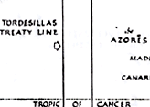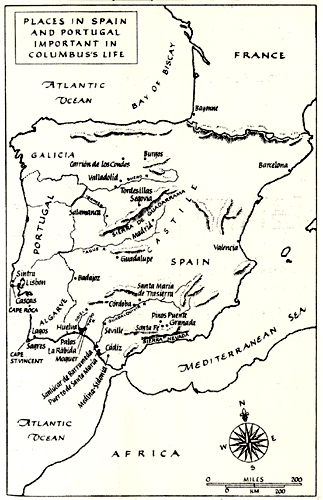Pre-Encounter Spain Notes
1450 – 1492 (1494)
I.
Spain
711 - 1492: the Context
In
711, Muslims from North Africa (principally, Morocco)
conquered 90% of the Iberian peninsula and advanced for a generation as far as
the middle of France.
For the next 781 years, nearly eight centuries, the European
late-Latin-speaking Christians from the extreme northern areas of north central
Iberia fought to reconquer the Iberian
peninsula from Arabic-speaking Muslims from north Africa who
called their home in Iberia Al-Andalus. From the European perspective, this
long period of intermittent struggle and war is known as the Reconquest (la reconquista). The reconquest was
cultural, linguistic, and religious. In a sense, it was like the Crusades, but
on a strictly local level. At the same time, it must be understood, that after
the Jewish Diaspora from Jerusalem and Palestine in 70 CE, Iberia became one of the principal
homes for the next fourteen centuries of the Jewish people. Hebrew-speaking
Jews came to calle their home Sepharad (Spain, in Hebrew). However,
precisely because the Reconquista was local, because it was so gradual, and
because there were three main ethnic, religious, and linguistic groups involved
(Muslims, Jews, and Christians), a lot of mixing and fusion took place among
all of these peoples. It has been said anecdotally that the ethnic and racial
mixture that makes up Spaniards today is one-third Palestinian Jewish,
one-third African Muslim, and one-third European Christian. Of course, Spain today is
95% Catholic, but Spanish culture retains a strong sense of being the product
of centuries of mixture.
By the thirteenth century, in the center of
the peninsula a kind of fragile yet, for its time or, perhaps, any time, a
unique harmony had developed between the three contending groups. This harmony
is known as the Convivencia ("living
together"; no single English word faithfully translates convivencia). Nevertheless, by the
end of the next century the convivencia began to break apart. In 1391, for
example, horrifiic pogroms broke out all over the peninsula, during which
thousands of Jews were killed by fanatical Christians. Meantime, the once
flourishing Muslim civilization of Al-Andalus had been reduced to a small,
tribute-paying kingdom in the southeastern segment of the peninsular centered
on the city of Granada.
II. 1450 - 1492
While
the rest of Europe had been gradually evolving out of the medieval constructs
of the Middle Ages, poor and chaotic Spain was still living out the last
struggles of the Reconquest. Unlike the slow pace of events during Spain's Middle
Ages, over these 42 years events happened rather fast, and dramatic changes
occurred. In a phrase, Spain
evolved from a medieval conglomeration of small states to the world's first
nation-state. The woman who would become queen Isabel la Católica (Isabel I of
Castilla, later, of Spain)
in 1474 was born in 1451. The man whom she would marry, Fernando de Aragón, and
who would become known as Fernando el Católico (together they are los Reyes
Católicos, so designated by the pope), was born in 1452. Also in
1452, in Germany,
Johannes Gutenberg published the first book ever printed on movable type, the
famous Gutenberg Bible. This invention would revolutionize and democratize the
world of knowledge and learning, thereby giving a technological infrastructure
to the development of the new European model of culture, the Renaissance. Two
other major European events that signalled the end of the Middle Ages, and
therefore the beginning of a new era, are the facts that, first, the so-called
One Hundred Years War, which actually began in 1337, ended in 1453. Second, the
Muslim Ottoman Turks captured Constantinople at the eastern edge of Europe,
thus ending the almost 1,500 years of the Roman Empire
both of the East and the West. All of these major events would impact Spain in
significant ways during the lives of the Reyes Católicos.
Isabel
and Fernando, two very active, intelligent, well educated, and ambitions young
heirs to their respective thrones (Castilla and Aragón, the two most prominent
Christian kingdoms on the Iberian peninsula,
emarried in 1469. In 1474, Isabel ascended to the throne. Five years later, in
1479, Fernando became king Fernando II of Aragón. Thereafter, their kingdoms
were united in ways that, although complex, were sufficiently effective to
create a powerful new national entity that historians have long called the
world's first nation-state. This union was the first big step toward achieving
national unity. Under the pretext to create religious unity in Castilla, in
1478 (the Inquisition began earlier in Aragón), Isabel set up the Spanish
Inquisition, whose main purpose was to eliminate Spaniards were were thought to
have converted (conversos)
from Judaism to Christianity. This was the second significant step intended to
create national unity. From 1478 unitl 1834, the Inquisition effectively
silenced religious freedom of conscience and freedom of expression in Spain. The
third major unifying step took place in 1482, when Fernando and Isabel united
their financial and military assets in a campaign to finish the Reconquista, which
had begun in 718 in Covadonga, Asturias, in northern Spain. This last war of reconquest
against Al Andalus was directed toward the last remnant of Muslim Spain in the kingdom of Granada. This war, which sometimes is
referred to as the last of the medieval Crusades, lasted from 1482 to 1492. By
conquering Granada, all Iberians lands were
ruled by Christian monarchs--Navarra in the extreme north, Portugal to the west, and the Reyes
Católicos in the most powerful of these kingdoms, which was
beginning to be known as Spain.
III.
1492
The
most dramatic of the events that occurred in Spain
in the year 1492 (January) was the Christian reconquest of Granada. Yet another very significant
unifying event in Spain during the reign of the Reyes Católicos also
occurred in 1492. It was the bitter and tragic decision by the Catholic
Monarchs (Reyes
Católicos) to force all Jews living in Spain either to convert
immediately to Christianity (perhaps as many as a third chose to do so) or go
into permanent exile (deadline: July 31st). As many as 300,000 Jews left Spain (Sepharad) by the deadline (July 31st),
thereby spreading Spanish-speaking Sephardic Judaism first around the Mediterranean and later around the world. Jews who
converted then formed an active and influention social class whose members were
known as conversos.
This expulsion of Jews who remained faithful to their religion is the fourth
major step undertaken by the Reyes Católicos under the guise of unifying their
nation-state. Later on, the disappearance of the talent, energy, creativity,
and skills of Spain's Jews,
along with the continuing persecution of the conversos, would contribute
to Spain's
long and slow decline. But, for the next century, Spain expanded exponentially. In
1502, Spain's
Muslims were given the same "choice" as the Jews were given a decade
earlier. Most Muslim Spaniards converted, but these moriscos would be
expelled finally in 1609.
All
of the events mentioned above impact the character and nature of Spain, the
first European nation to extend its power into the Western Hemisphere; but the
last major event Spain in 1492 is, of course, the sailing of Cristóbal Colón
(English version of his name from Latin: Christopher Columbus), commanding
three ships, the Niña, the Pinta, and the Santa María, from Spain to an Island
in the Bahamas and then around much of the Caribbean. Although queen Isabel's
support for Columbus' adventure was not intended as one of the grand unifying
acts that she and her husband Fernando made on behalf of the unification of the
nation-state of Spain, the result of Columbus's discovery (or encounter), over
the next three centuries, would become the source for creation of the Spanish
empire, the largest, most extensive, richest, and most powerful empire the
world has ever known. When combining the long-gestating historical forces that
came together to create modern Spain
with Columbus's discovery pre-Columbian America begins to become Latin America, even
though the term "Latin" America would not be used until the
nineteenth century.
III.
Tordesillas
In
1493, the monarchs of Spain
and Portugal went to Pope
Alexander VI, who came from a powerful Spanish aristocratic family, to
negotiate a line of demarcation between the regions of the "New
World" encountered by Columbus
and claimed by both countries. Both countries were still behaving in a medieval
fashion according to which the European pope's sacred or religious authority
was valued above all other earthly authorities. In a papal bull called "Inter
Caetera", the pope divided regions of possession and the right of conquest,
settlement, and colonization 100 leagues west of the Azores islands in the Atlantic Ocean. Portugal protested that they were given
almost no part of the so-called new world, so, in 1494, in the small Castilian
city of Tordesillas, these two nascent colonial nations negotiated the Treaty
of Tordesillas, according to which they moved the line of demarcation 370 leagues west of the Cape Verde Islands (off
the west coast of Africa). For a drawing
of these two lines of demarcation, click on the following image:
 |




